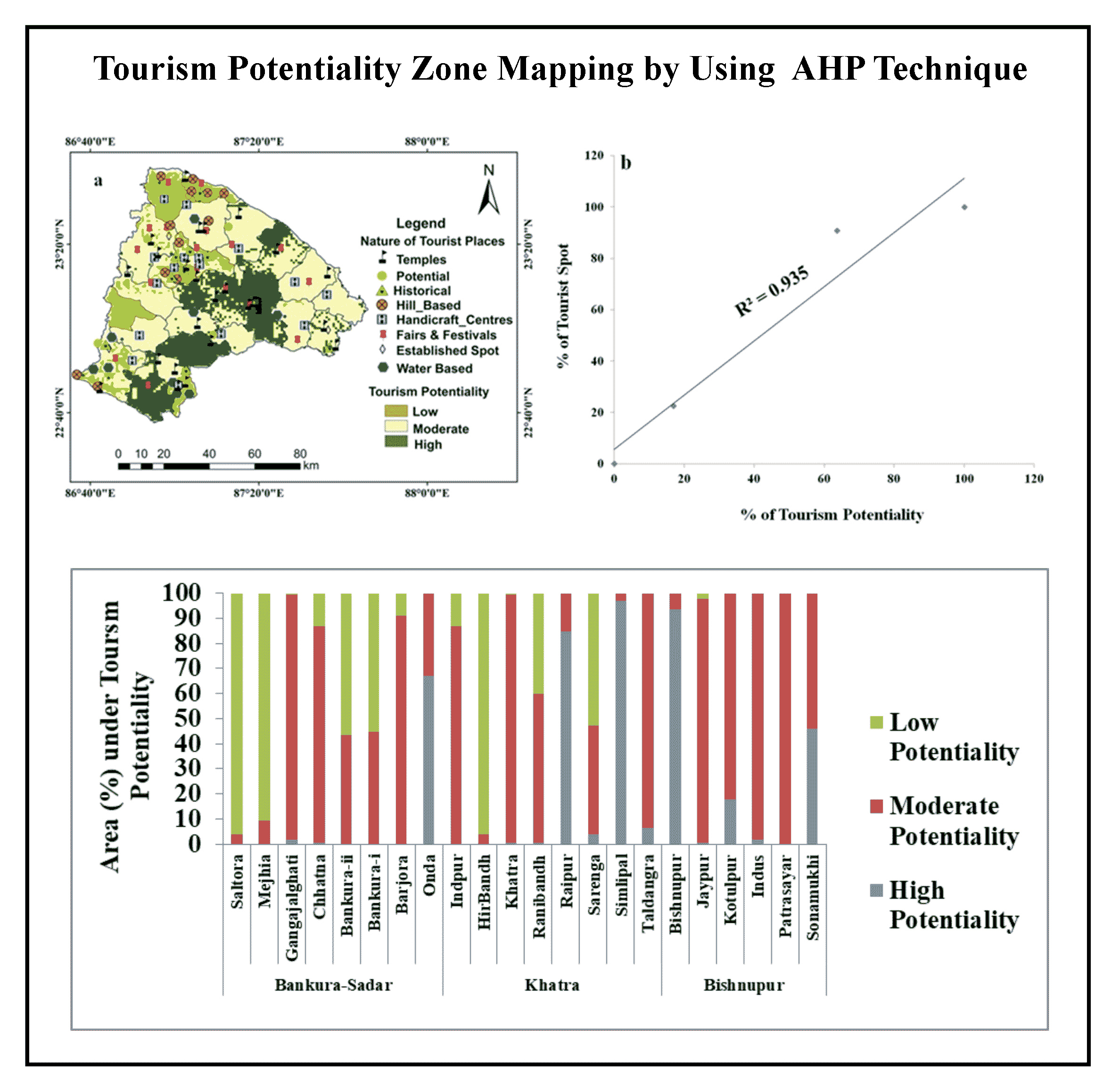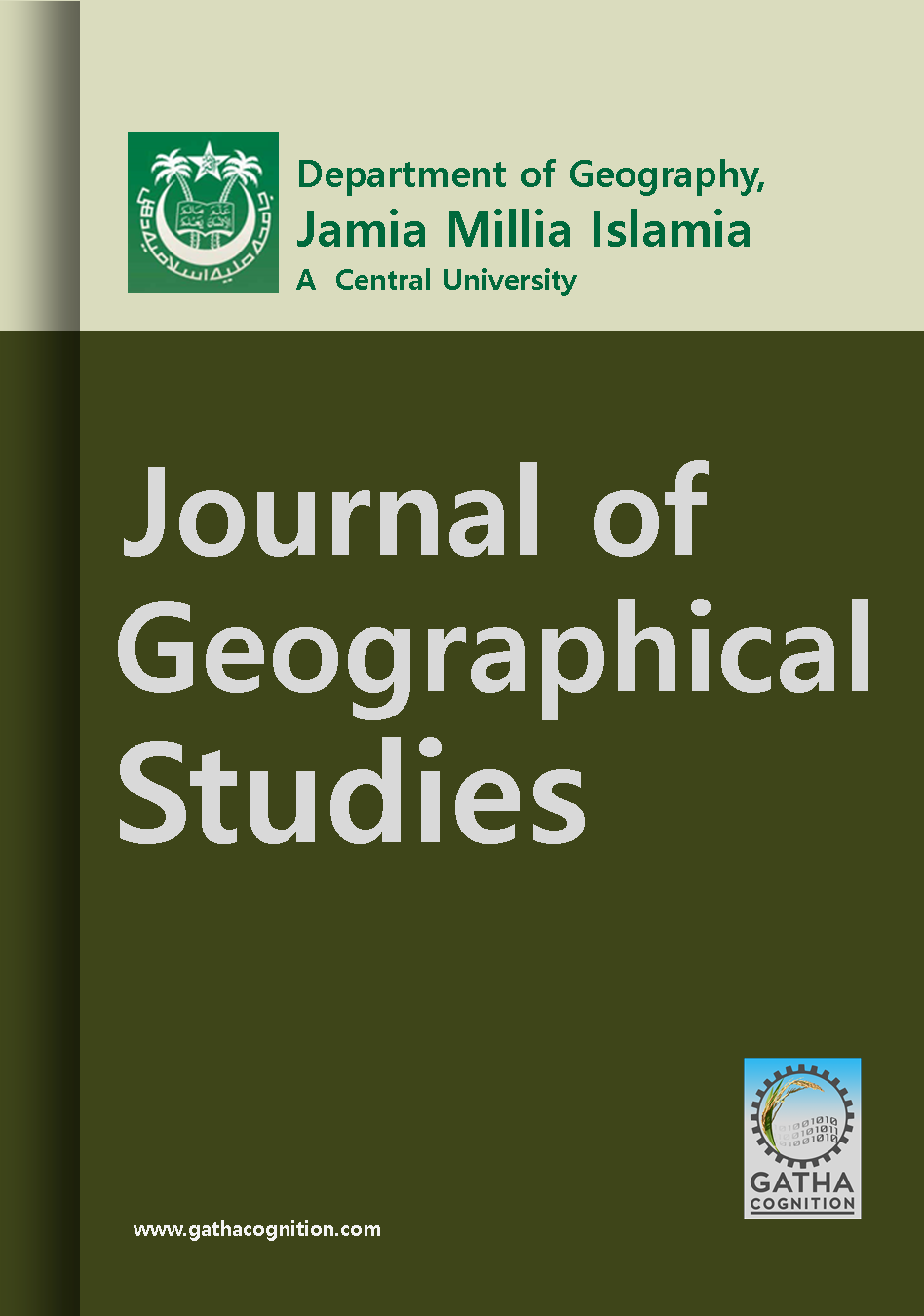Article Title :
Influence of Altitude and Climate on the Distribution of Vegetation, Ecosystem Services and Human Population in Garhwal Himalayan Region 
9 (2025)
11-33
Geospatial technique , Remote Sensing , relative relief , population distribution , Himalayan livelihood , Garhwal Himalayas


Altitude plays a crucial role in determining habitat distribution, species diversity, and ecological resources, which support livelihoods and employment in the Himalayan region. Covering 18% of India's territory, the Himalayas house over 50% of the country's forest cover and 40% of the Indian subcontinent's endemic species, providing ecosystem services to 115 million people. However, the relationships between elevation, ecological services, and population resource dependency are poorly understood. This study examines the spatial linkages between elevation, climate, and ecosystem distribution, as well as the relationship between ecosystem services and population density using livelihood indicators. Spatial analysis reveals an inverse relationship between population density and relative relief (-0.69; P<0.05). Population density is concentrated (14.44%) along the fertile Alaknanda and Bhagirathi River valleys (900–2200m), which cover 14.95% of the area. Conversely, 5.33% of the population is scattered across 41% of the region, with higher elevations (>2000m) relying on non-timber forest products (NTFPs) for over 30% of income. These findings highlight critical patterns in population distribution, resource dependency, and ecosystem services, offering valuable insights for policymakers to promote biodiversity conservation, equitable resource sharing, and sustainable development in the Himalayan region.

Distribution of vegetation with altitude in the Himalayan region assessed using remote sensing and geospatial techniques.
In the Garhwal region, 14.44% population with high-dense category residing along the River valleys.
The negative association was observed between population density and relative relief.
In high altitude regions (>2000m) with available pastures, over 30% population depends on NTFPs gathering and earnings.
Relative relief and climate influence on livestock husbandry and non-timber forest products (NTFPs) in the Himalayan region.
Asthana, V. K. and Vir, K., 1991. Cluster analysis in the identification of Morpho unit: Pervikhala drainage basin - A case study. In Sharma, H. S. (Ed.). 1991. Indian Geomorphology: Selected Papers from the 2nd Conference of the Indian Institute of Geomorphologists on Environmental Geomorphology, 123-136. Concept Publishing Company.
Bahukhandi, A., Chandra Sekar, K., Negi, V. S., Bisht, K., Tiwari, D. C., Mehta, P., Upadhyay, S., Siddiqui, S. and Ayari-Akkari, A., 2024. Floristic diversity and species composition along altitudinal gradient in the alpine ecosystem of the cold desert region in Western Himalaya, India. Frontiers in plant science, 15, 1469579.
Bisht, I. S., Rao, K. S., Bhandari, D. C., Nautiyal, S., Maikhuri, R. K. and Dhillon, B. S., 2006. A Suitable site for in situ (on-farm) management of plant diversity in traditional agroecosystems of Western Himalaya in Uttaranchal State: A case study. Genetic Resources and Crop Evolution, 53(7), 1333–1350.
Biswas, S. S., Pal, R., Pramanik, M. K. and Mondal, B., 2015. Assessment of anthropogenic factors and foods using remote sensing and GIS on lower regimes of Kangshabati-Rupnarayan River Basin, India. International Journal of Remote Sensing GIS, 4(2), 77-86.
Chaudhary, S., Kumar, A. and Negi, M. S., 2019. A geospatial appraisal of Garhwal Himalayan bio-geodiversity and its eco-tourism potentials. IJRAR, 6(1), 911-926.
Chaudhary, S., Negi, M. S. and Kumar, A., 2018. Ecotourism aesthetics and prospects: A geospatial assessment of Rajaji National Park. Review of Research, 2331(48514), 1-17.
Dhanai, R. and Parmar, M., 2014. Fuelwood and Fodder Consumption Pattern in Uttarakhand Himalayan Watershed. International Journal of Environmental Biology, 4(1), 35-40.
Ellu, G. and Obua, J., 2005. Tree condition and natural regeneration in disturbed sites of Bwindi Impenetrable forest national park, Southwestern Uganda. Trop Ecol 46(1), 99-111.
Heim, A. and Gansser, A., 1939. Central Himalaya, geological observations of the Swiss expeditions 1936. Mem. Soc. Helv. Sci. 73.
Joshi, B., 2018. Recent trends of rural outmigration and its socio-economic and environmental impacts in Uttarakhand Himalaya. Journal of Urban and Regional Studies on Contemporary India, 4(2), 1-14.
Kan, A., Zhu, L. D., Gong, J. H. and Chen, Z. L., 2006. Development of the swath profile tool based on ArcView GIS and its application in morphometric analysis. J Chengdu Univ Tech Sci-Tech, 33, 64-69
Kaushik, S. D., 1962. Climatic zones and their related socio-economy in Garhwal Himalaya. Geog. Review, 24(3-4), 29.
Kharkwal, S. C., 1993. Physico-Cultural Environment and Development in UP Himalaya. Nutan Publications.
Kumar, A., Singh, S., Pramanik, M., Chaudhary, S., Maurya, A. K. and Kumar, M., 2021. Watershed prioritisation for soil erosion mapping in the Lesser Himalayan Indian basin using PCA and WSA methods in conjunction with morphometric parameters and GIS-based approach. Environment, Development and Sustainability, 24, 3723-3761.
Kuniyal, H. B., Semwal, S., Tiwari, O. P. and Sharma, C. M., 2024. Forest composition and resource utilization patterns in relation to anthropogenic pressure in moist temperate forests of the Garhwal Himalaya. Environment and Ecology, 42(4A), 1726-1735.
Nand, N. and Kumar, K., 1989. The holy Himalaya: A geographical interpretation of Garhwal. Daya Books.
Pal, R., Biswas, S. S., Mondal, B. and Pramanik, M. K., 2016. Landslides and foods in the Tista basin (Darjeeling and Jalpaiguri Districts): Historical evidence, causes and consequences. Journal of Geophysics Union, 20(2), 209-215.
Pandey, A. N. and Singh, J. S., 1985. Mechanism of ecosystem recovery: A case study of Kumaun Himalaya. Recreation and Revegetation Research, 3, 271-292.
Partap, T., 2011. Hill agriculture : Challenges and opportunities. International Journal of Agriculture Economics, 66(1), 33-52.
Rao, K. S., Semwal, R. L., Maikhuri, R. K., Nautiyal, S., Sen, K. K., Singh, K., Chandrasekhar, K. and Saxena, K.G., 2003. Indigenous ecological knowledge, biodiversity and sustainable development in the central Himalayas, Tropical Ecology, 44 (1), 93-111.
Rawal, R. S., 2020. Complying with biodiversity conservation initiative that holds the future for Himalayan people. In Himalayan Biodiversity and Future Solutions. G.B. Pant ‘National Institute of Himalayan Environment (NIHE) Kosi-Katarmal, Almora, Uttarakhand, 1, 13-14.
Rawat, V. S., 2010. Problems of animal grazing in Uttarakhand Himalaya. Researcher, 2(5), 81-85.
Sati, V. P. and Singh, R. B., 2010. Prospects of sustainable livestock farming in the Uttarakhand Himalaya, India. Journal of Livestock Science, 1, 9-16.
Sati, V. P., 2008. Natural resource management and food security in the Alaknanda Basin of Garhwal Himalaya. ENVIS Bulletin: Himalayan Ecology, 16(2), 1-11.
Sharma, C. M., Gairola, S., Kumar, M., Rawat, Y. S. and Bagwari, H. K., 2009. Resource utilisation in village ecosystem of temperate zone of Garhwal Himalaya. Indian Journal of Agroforestry, 11(2), 94-1.
Sharma, C. M., Suyal, S., Gairola, S. and Ghildiyal, S. K., 2009. Species richness and diversity along an altitudinal gradient in moist temperature forest of Garhwal Himalaya. J Am Sci, 5,119-128.
Shiva, V., Singh, V., Dankelman, I., Negi, B. and Singh, S., 2005. Biodiversity, Gender and Technology in Mountain Agriculture.
Singh, D., Srivastava, R. K. and Khanduri, V. P., 2005. Marketing strategies and trade of medicinal plants in Uttaranchal: Present and future prospects. Indian Forester, 131(3), 330-340.
Singh, N., Tewari, A. and Shah, S., 2019. Tree regeneration pattern and size class distribution in anthropogenically disturbed sub-alpine treeline areas of Indian western Himalaya. International Journal of Scientific and Technology Research, 8(8), 537-546.
Tewari, P., Singh, R. D. and Jacob, N., 2020. Promoting bio-resources as a viable livelihood option for biodiversity conservation and livelihood enhancement in Central Himalayas. In Himalayan Biodiversity and Future Solutions. G.B. Pant ‘National Institute of Himalayan Environment (NIHE) Kosi-Katarmal, Almora, Uttarakhand,1, 17-19.
Valdia, K. S., 1979. Kumaon Himalayas. Tectonic Geology of the Himalayas, 1-14.
Zhang, H. P., Liu, S. F., Sun, Y. P. and Chen, Y. S., 2006. The acquisition of local topographic relief and its application: An SRTM-DEM analysis. Rem Sens Land Res, 1, 31-35.





